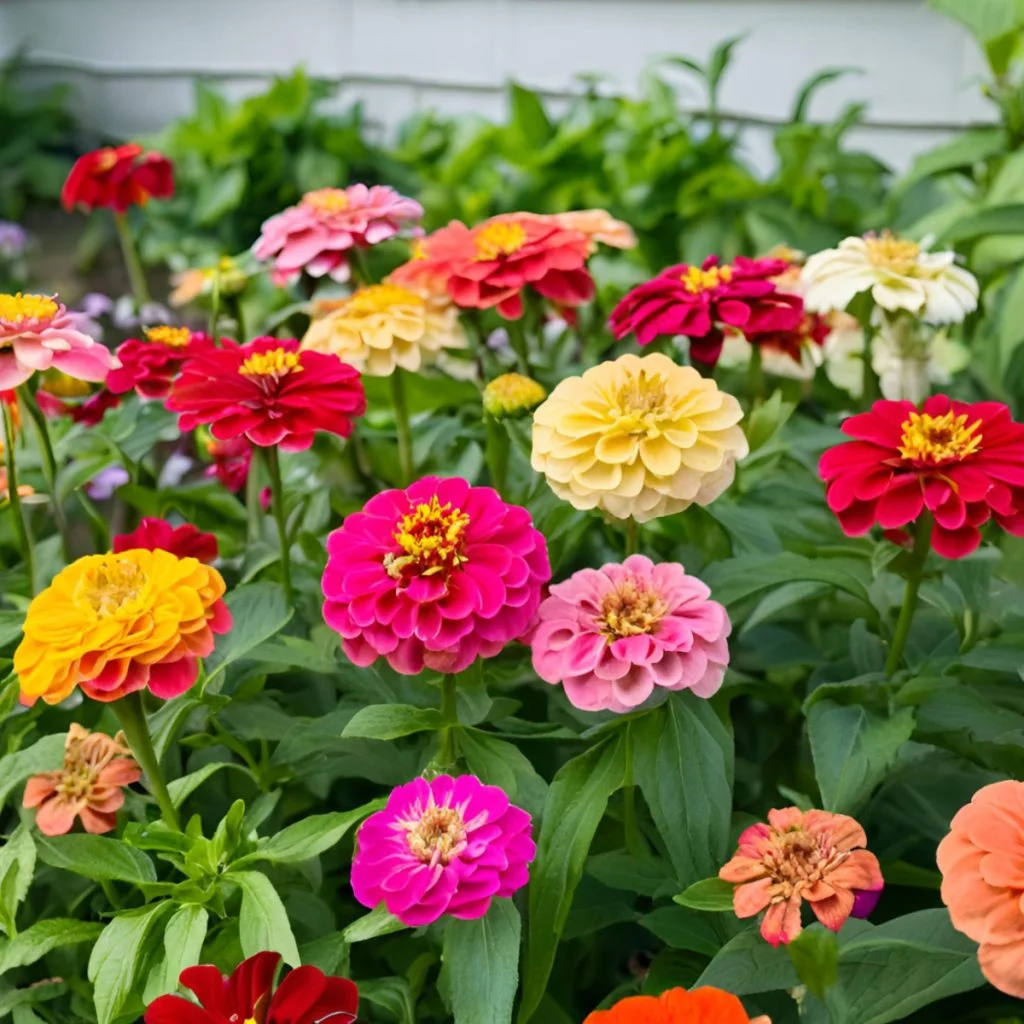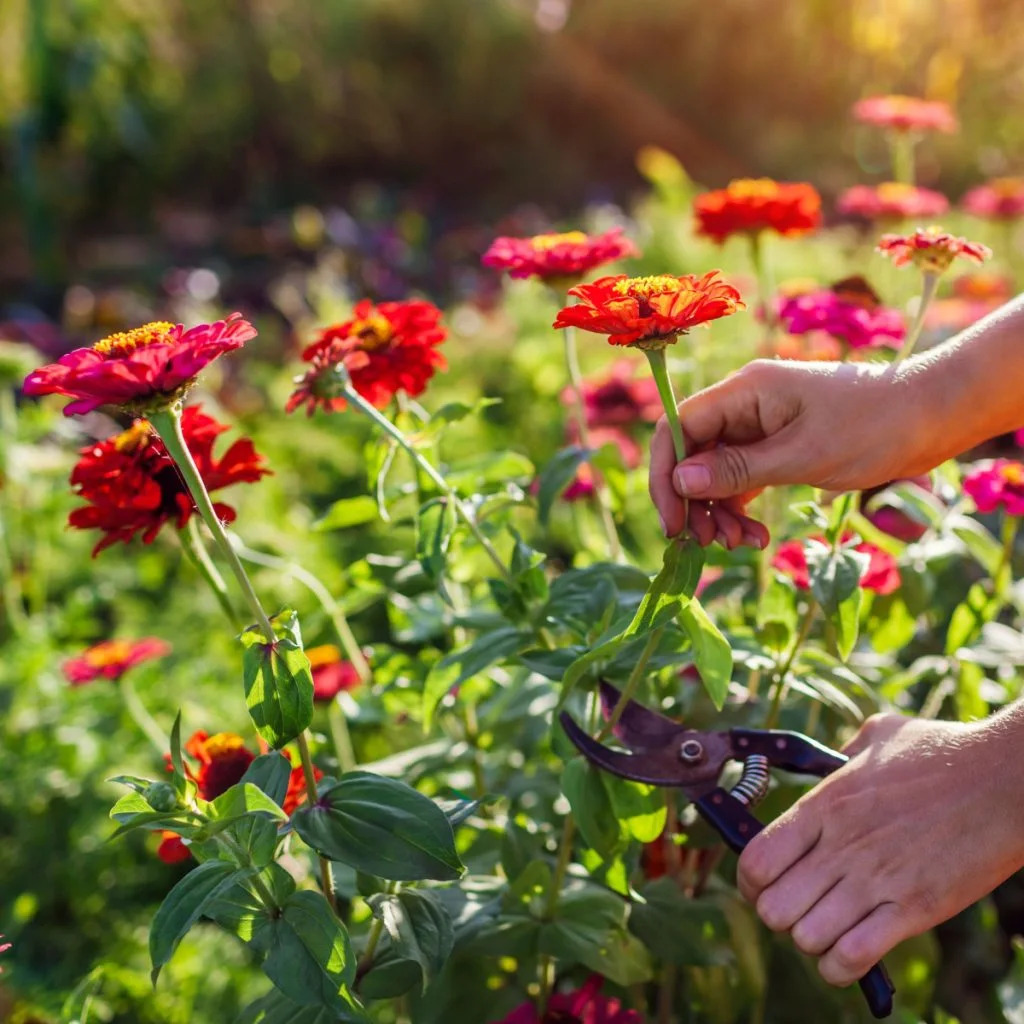Looking for a few tips and tricks to keep your zinnias blooming bright and big in your flowerbeds and garden all summer long?
If you want a flower that can brighten up your landscape for almost the entire growing season, it’s hard to beat zinnias. Their colorful, daisy-like blooms are not only beautiful, they’re also incredibly easy to grow. Even better, with the slightest of care, you can keep them constantly flowering.
Zinnias are known as a “cut and come again” flower. That simply means the more you cut them for fresh flowers, or deadhead their fading blooms as they die off, the more they will bloom. And as you will see below, by simply doing this and a few other simple tasks throughout the summer, they are one of the easiest annuals of all to keep flowering!

3 Simple Keys To Keep Zinnias Blooming All Summer
#1 Deadheading & Cutting
Zinnias are “born” to create seeds. Because of this, one of the biggest secrets to keeping zinnias blooming non-stop is to cut them often. Zinnias thrive on being cut. When you remove their flowers, whether by deadheading old blooms or harvesting fresh ones for bouquets, it triggers the plant to send out even more blooms.
When zinnias are left to go to seed, they will slow down or even stop flowering. But by deadheading and cutting off the dying flower heads – you’re keeping the plant focused on blooming instead of seed production. The plant simply knows it has to produce more flowers to make seeds.
If cutting for flower arrangements, you can cut lower on the stem to allow for plenty of stalk for the vase. This also has the added benefit of keeping zinnias more compact as they grow. This not only keeps the plants looking neat, but it sends a signal to the plant to create another flower stem.
If simply deadheading, you can either cut low, or snip the old flower off just above the next set of leaves below the bloom. When snipping just under the bloom, this will create the next bloom set at a higher level. Whichever way you choose – the important part is to remove those old blooms on a regular basis!

Giving Zinnias The Right Amount Of Water To Keep Them Blooming
When it comes to blooming power, watering also plays a huge role in how well your zinnias perform. Zinnias are fairly drought-tolerant once they’re established, but if you want them to bloom big and bloom often, consistent watering without overwatering is key. In fact, if there is one mistake gardeners make with zinnias, it is giving them too much water.
Zinnias prefer to have a slightly moist soil, but not soggy. That means you don’t want to water them every day unless your soil dries out fast or you’re experiencing extreme heat. Instead, aim to water deeply once or twice a week.
This encourages the roots to grow down deep, which helps the plant stay strong and resilient during dry spells. It’s best to try to keep the soil evenly moist about 3 to 5 inches below the surface. If it’s still damp, wait a day or two and check again.
Unsure to tell the moisture level down deep? One of the easiest ways to tell soil the level of moisture in the soil is with a soil meter. The inexpensive garden tool is perfect for helping gardeners know when to water – and when to avoid watering. Affiliate Link: Long Probe Soil Moisture Meter.
Other Watering No-Nos
Avoid watering your zinnias from overhead, as wet foliage can lead to powdery mildew and other fungal issues. It’s better to water at the base of the plant using a watering wand, soaker hose, or drip system. This keeps the leaves dry and helps the water get right where it’s needed – at the roots.
Mulching around your zinnias will also help keep moisture in the soil and reduce how often you need to water. With zinnias, don’t mulch heavy and thick, but instead just a few inches. This will keep the roots from becoming overly wet and rotting away.

Why Fertilizer Isn’t The Best To Keep Zinnias Blooming
One of the great things about zinnias is that they don’t need much to thrive. In fact, too much care -especially in the form of fertilizer – can actually harm their ability to bloom.
Zinnias are native to areas with poor soil, and they grow far better when they do not have access to an overload of nutrients. Many gardeners make the mistake of fertilizing their zinnias too often, thinking it will encourage more growth and flowers. But instead of more blooms, what usually happens is an explosion of leafy green growth with very few flowers.
Too much nitrogen in the soil is the main cause of this issue. Nitrogen promotes leafy growth, but it can slow or stop flower production. This is why it’s best to avoid using strong chemical fertilizers or even organic fertilizers with high nitrogen levels on zinnias.
Instead of traditional fertilizer, the best approach is to give your zinnias a light feeding of compost tea or worm casting tea every two to three weeks. These mild, natural feeds provide small amounts of nutrients that help support overall plant health without encouraging too much green growth.
Compost tea is made by soaking compost in water and then straining out the solids. The resulting liquid is full of beneficial microbes and trace nutrients. Worm casting tea is made the same way, but using worm castings instead of compost. Affiliate Link: 16oz Worm Castings for Plants – Makes 32 Gallons of Earthworm Castings Compost Tea
Both are excellent for feeding zinnias gently, and because they’re natural and mild, they won’t overpower the plants. Just water your zinnias with the tea as you would when watering normally, making sure to soak the soil around the base of the plant.
Don’t Forget To Save Seeds For Next Year!
Another great benefit of growing zinnias is that you can save your own seeds for next year’s planting. Once fall arrives and you’re ready to let your zinnias go to seed, stop deadheading and let a few flower heads dry out completely on the plant.
When the petals are dry and brown and the center of the flower feels firm and dry, you can clip the entire bloom off the stem. Pull the dried petals away and you’ll find the seeds attached at the base where the petals once were. These are small, arrow-shaped seeds that you can easily collect and store.
Place the seeds in a paper envelope or a small jar with the variety labeled on the outside. Store them in a cool, dry place until spring. When next year rolls around, you’ll be ready to plant your own homegrown zinnia patch, and you’ll know exactly where the seeds came from.
Saving your own seeds not only saves money, but it also allows you to select the healthiest, best-performing plants in your garden to reproduce. And nothing can help your garden and flowerbeds like zinnias can. See our article: Why To Grow Zinnias In Your Vegetable Garden – The Ultimate Companion Plant!
Here is to helping your zinnias bloom big all summer long this year – and even into fall!
This Is My Garden
Follow Our Facebook Page For Great Gardening Tips And Advice! This Is My Garden Facebook Page
This Is My Garden is a garden website created by gardeners, for gardeners. Jim and Mary Competti have been writing gardening, DIY and recipe articles and books and speaking for over 15 years from their 46 acre Ohio farm. They publish three articles every week, 52 weeks a year. Sign up today to follow via email, or follow along!

